Blowin’ in the wind: traditional windmills you can visit in the Netherlands
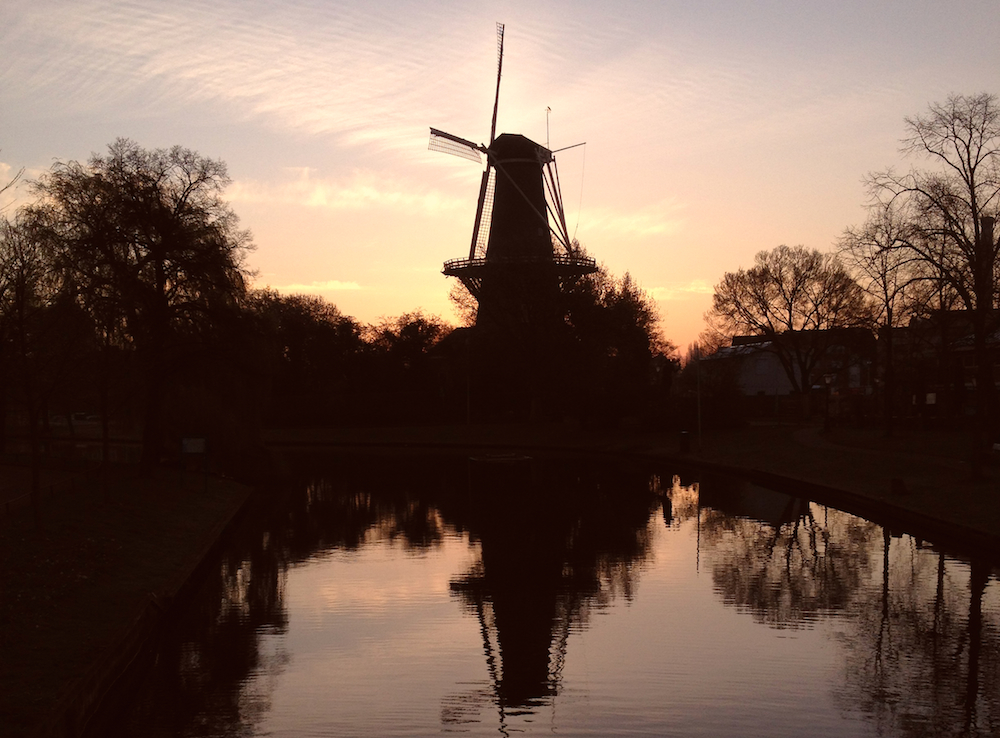

What’s the first thing that springs to mind when most people think of the Netherlands? If this were a question on a game show, windmills would probably be the number one answer. If you’ve never experienced the joys of climbing to the top of one of these ubiquitous structures, or merely drinking a biertje beside one, here’s a few that you can visit (and, in some cases, even spend the night in).
Zaanse Schans – Zaandam
Okay, let’s get the most obvious ones out of the way first. What’s it like to actually visit the country’s best known windmills? In a word: crowded, especially during the summer months.
Visitors and residents alike are daunted by the mobs that pour out of tour buses like clockwork every day between April and October to clog up the small community’s picturesque lanes, museums, windmills and, yes, no less than six gift shops.
If you’re unwilling to put up with conditions comparable to Disney World, plan your visit for the off-season. It’s a trek worth making at least once. Zaanse Schans’ museums will tell you more than you ever wanted to know about windmills. Just please be mindful of the locals who’d rather not have anymore people tromping across their yards in search of the perfect Instagram selfie.
Kinderdijk – Molenwaard
Kinderdijk is the *other* incredibly popular place to snap photos of windmills in the Netherlands. Many might go so far as to call it a tourist trap, and local cyclists have all but declared war on the thousands of visitors who head down there every year.
If you go, there’s a good chance you will receive the bike bell dinging of a lifetime from one of them as you march along the village’s shared paths. That said, its 19 windmills are so photogenic and treasured they’ve been on the UNESCO World Heritage site list since 1997.
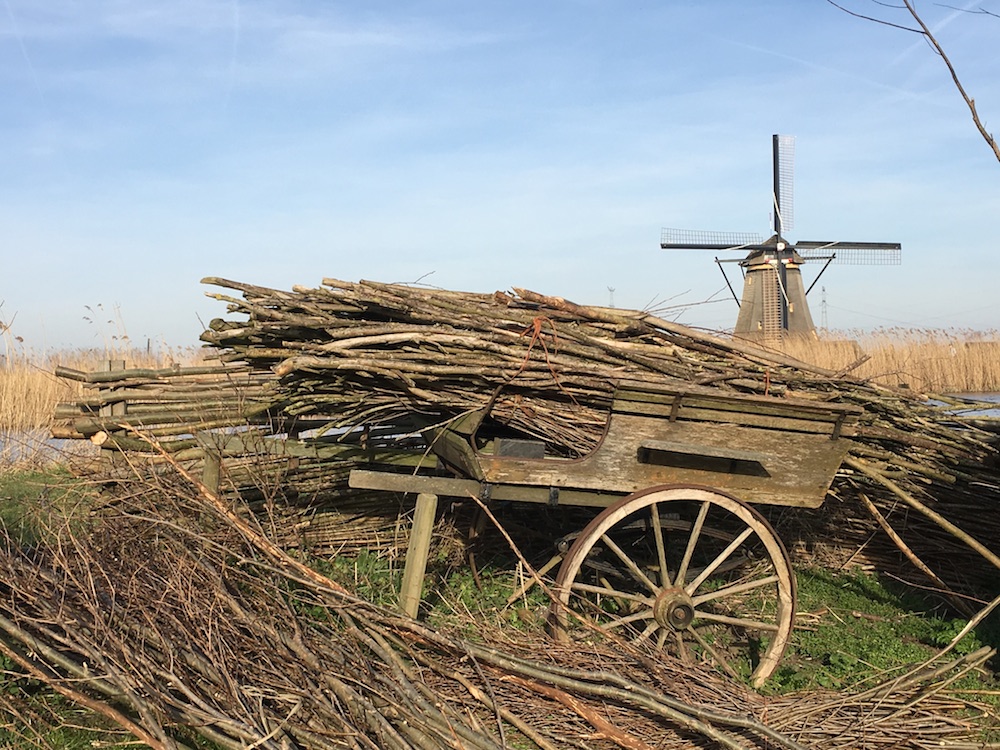
They were originally constructed to help prevent flooding in the surrounding area. Some of them are private, but there are a few you can explore that feature informational displays about what it’s like to live and work in them. If you go, keep an eye out for the floating cradle, which serves as a monument to the Dutch legend that allegedly inspired ‘The Cat and the Cradle’.
De Valk – Leiden
If you’d like to climb around in a windmill but not deal with crowds, with the possible exception of a local school group, head to Leiden to visit De Valk. The 29 metre tall mill replaced a smaller one in 1743, and it’s proudly overlooked the city ever since. De Valk was converted into a museum in 1966 and received an extensive restoration this past winter.
You can visit the living spaces on the lower floors, which feature original furniture and decor, along with a viewing deck. De Valk has also been in regular operation since the early ‘00s and the sails can often be seen spinning when the weather’s behaving. Be sure to wear a sturdy pair of shoes if you’re determined to make it up each thin staircase (they’re more like ladders, really) that lead to the viewing deck.
De Gooyer – Amsterdam
Exploring windmills might not be your thing. If you’d rather merely gaze up at one while enjoying an adult beverage, look no further than De Gooyer. Also known as De Funenmolen, it’s Amsterdam’s tallest windmill. It’s also conveniently located beside a former bathhouse that’s currently home to a taproom operated by Brouwerij t’ IJ, a beloved local craft brewery.
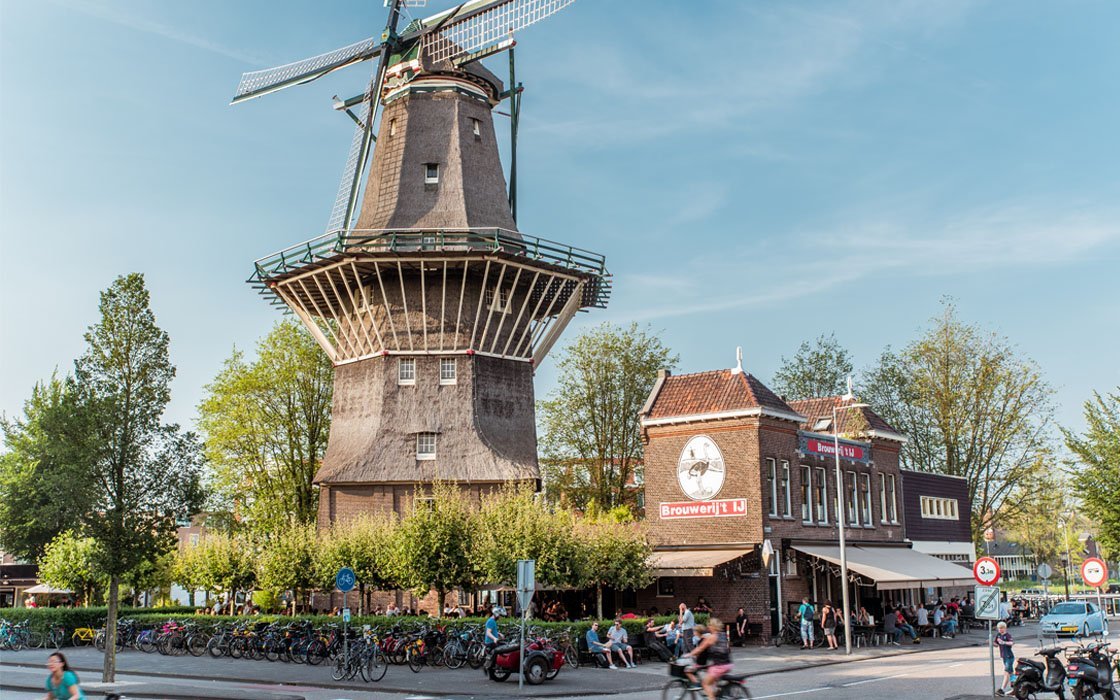
Contrary to popular belief, De Gooyer isn’t open to the public or owned by the brewery, although the windmill does appear in some of its promotional materials. Nevertheless, it’s great to look at while sitting on the terrace next door with an IPA and a wooden board layered thick with osseworst and cheese.
De Arkduif – Bodegraven
This 17th century windmill was once used to grind grain and also has ties to a craft brewery. It’s served as the home of Brouwerij de Molen since the mid ‘00s. The property was later expanded to include a taproom, a cafe, and a bottle shop. Tours are offered most Saturdays and you can visit both the windmill and the company’s new-ish brewhouse down the street.
As for its name, which means ‘The Ark’s dove’ in English, that’s only been around since 1956. The windmill’s owner at the time held a contest and selected it from a list of suggestions. As the brewery’s website notes, much like the dove, it remains a ‘bringer of peace and happiness.’
Molen de Otter – Amsterdam
This picturesque 17th century windmill is off the beaten path and usually isn’t open to the public, but it’s worth pausing to take a photo of it if you’re ever in the area. You can find it along the Kostverlorenvaart, and it’s the last of the 49 windmills that once populated the area in what is said to be the world’s first industrial estate.
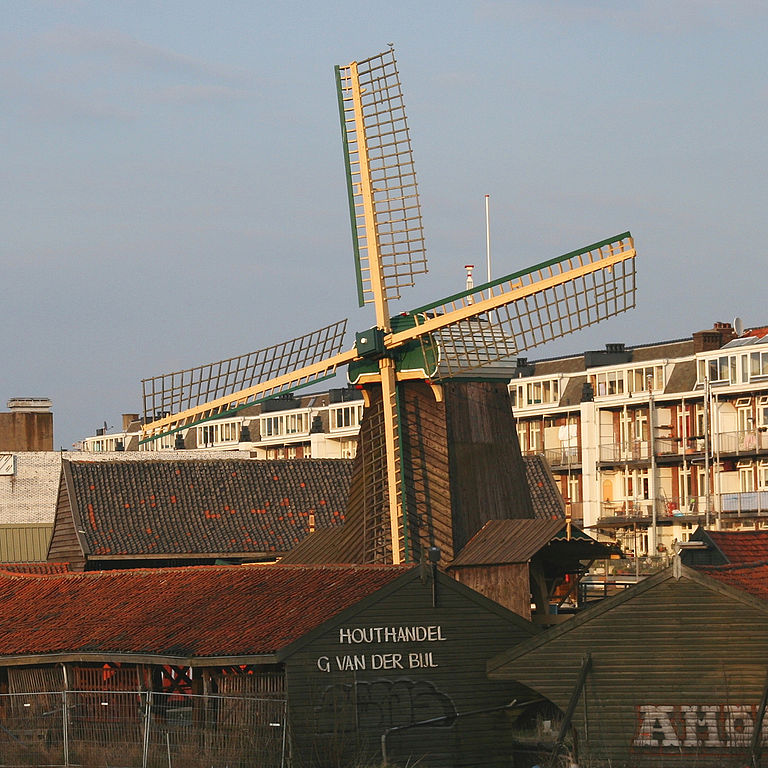
De Otter is also the oldest paltrokmolen in the country. The name comes from the paltrok, an old-fashioned men’s jacket. Supposedly back in the day, people thought these windmills resembled a person wearing one. De Otter was restored in 1994 and its warehouse still sits beside it.
The windmill is also operational but, sadly, newer buildings in the surrounding neighbourhood usually prevent it from catching enough wind for its sails to spin. Tours are offered on occasion, and you can find out more information about them by visiting De Otter’s Facebook page.
Molen de Walvisch – Schiedam
In the 18th century, Schiedam’s jenever industry was booming. It required new windmills to grind all the grain it needed to keep its distilleries running. There was just one problem: Schiedam wasn’t very breezy.
The community eventually constructed 20 very tall windmills capable of catching the wind. Now only five of the originals remain, and Molen de Walvisch is the one that’s currently home to a museum all about the city’s windmills and still thriving distilleries. Along with touring the former living quarters, you can also view a 180 degree audiovisual projection on the first floor.
Molen de Adriaan – Haarlem
This windmill sits along one of Haarlem’s most picturesque canals. It was built in the 1770s and was used to grind bark, tobacco, and other materials in the years that followed. In 1932, a devastating fire reduced it to little more than rubble and ash, but the locals started a fund-raising effort mere days later to get it rebuilt.
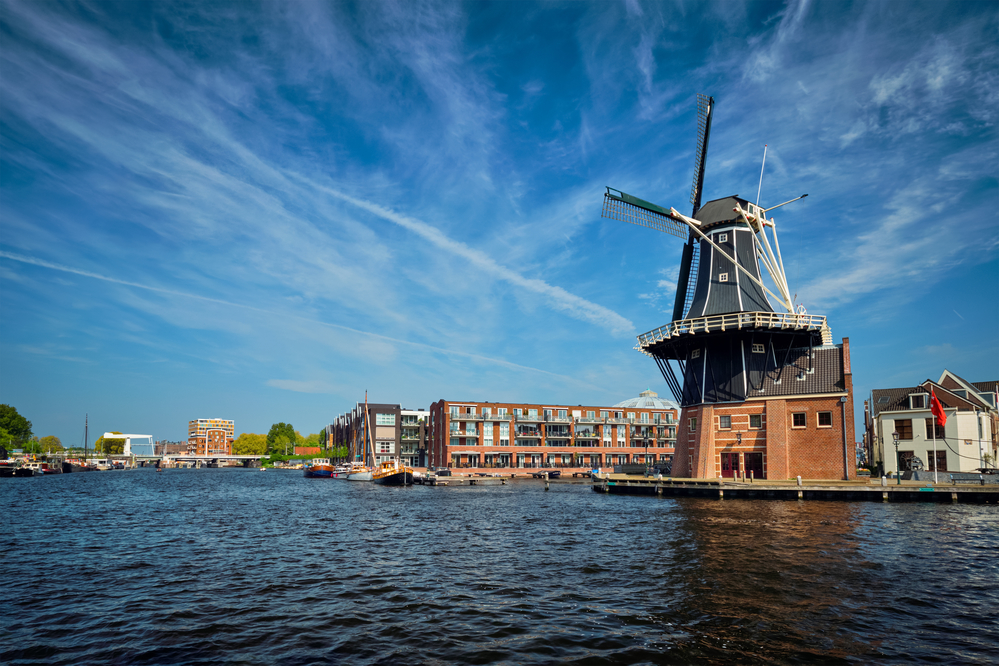
The project eventually took 70 years to complete and the restored Molen de Adriaan opened its doors in 2002. It now houses a museum and the first floor is available to rent for various events. If you’ve been dreaming of getting hitched in a windmill, here’s your opportunity.
De Noordmolen – Schiedam
Schiedam is also home to De Noordmolen, the tallest traditional windmill in the world. At one time, it was a grain mill considered vital enough to warrant the installation of a diesel engine to keep it operating on days when there wasn’t enough wind.
It was decommissioned in 1937 and much of it was deconstructed, leaving little more than a stumpy shell behind. Even worse, the Nazis used what remained as a watch tower during World War 2. Thankfully, it was restored to its former glory in the 1960s and 70s. Nowadays, De Noordmolen serves as a restaurant and bar.
Molen Rijn en Lek – Wijk bij Duurstede
You can bike right through the middle of this unusual windmill in the town of Wijk bij Duurstede. It was constructed over a town gate called the Leuterpoort in 1659 by a very determined gentleman named Anthony van Eyndhoven.
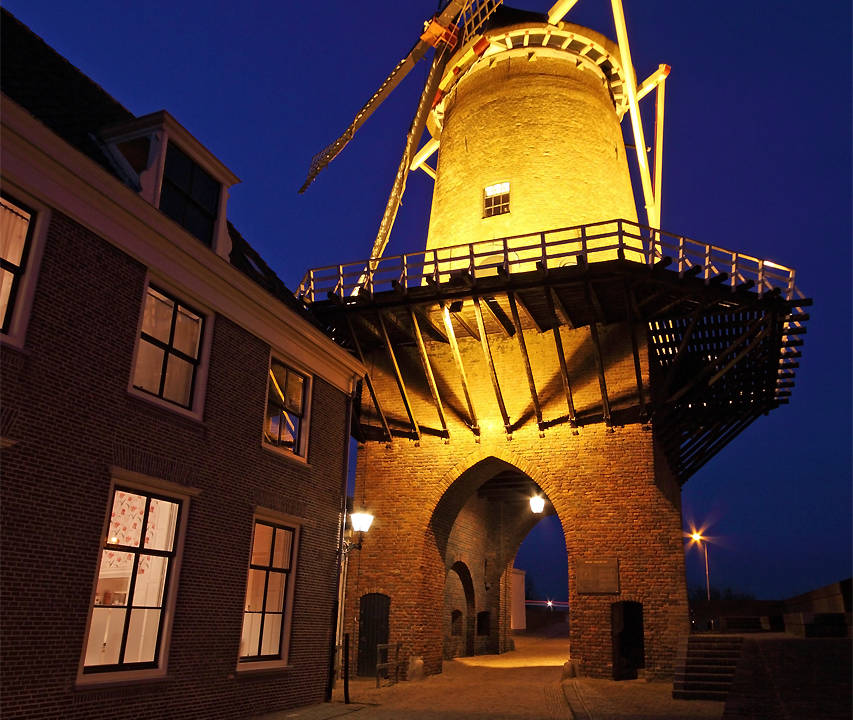
He managed to overcome both the logistics of getting it built and the protests of his neighbours, who were convinced the smell of all the bark being processed in the mill would drive them crazy. He eventually bought their house to get rid of them. Molen Rijn en Lek was rescued from demolition in the 1920s by a local group committed to the preservation of old windmills. It’s now open to visitors on Sunday afternoons or by appointment.
De Verrekijker – Bergharen
Finally, here’s the first of two windmills you can rent if you’ve ever wanted to sleep and/or ‘Netflix and chill’ in one. De Verrekijker was built in 1904 and was converted into a holiday rental in the 1960s. It has six bedrooms and can accommodate 12 people. You may actually want to invite 11 of your closest friends along because the rates aren’t cheap. However, it’s just a short walk from the village of Bergharen and the surrounding region is great for biking and hiking. If it is too pricey, there’s also another windmill you can rent in Onderdendam.
May 11 and 12 is National Windmill Day, when hundreds of mills will be open to the public nationwide. Find out more
Further reading: 10 things you should know about Dutch windmills
Thank you for donating to DutchNews.nl.
We could not provide the Dutch News service, and keep it free of charge, without the generous support of our readers. Your donations allow us to report on issues you tell us matter, and provide you with a summary of the most important Dutch news each day.
Make a donation